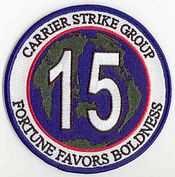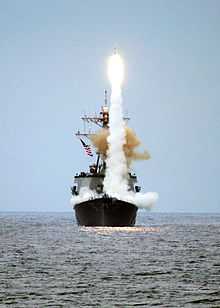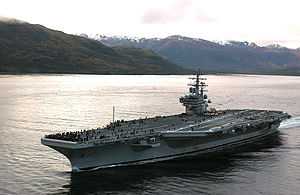Carrier Strike Group Fifteen
| Carrier Strike Group Fifteen | |
|---|---|
 Carrier Strike Group Fifteen patch | |
| Active | April 29, 2014 – present[1] |
| Country | United States of America |
| Branch |
|
| Role | Pacific Fleet Integrated/Advanced Strike Training |
| Part of | U.S. Third Fleet |
| Garrison/HQ | Naval Air Station North Island, California |
Carrier Strike Group Fifteen, abbreviated CSG-15 or CARSTRKGRU 15, the U.S. Fleet Forces Command formation charged with training and certifying Pacific Fleet Carrier Strike Groups, Amphibious Ready Groups, and independently deploying surface ships, replacing Strike Force Training Pacific.
Previously, CSG-15 was one of fourteen U.S. Navy carrier strike groups established on 1 October 2004..[2] U.S. Navy carrier strike groups are employed in a variety of roles, all of which involve gaining and maintaining sea control.[3]
Before 1 October 2004, the group was known as Cruiser-Destroyer Group 1. The group commander served as Immediate Superior-in-Command (ISIC) for the ships and units assigned to Carrier Strike Group Fifteen. As an Operational Commander, the group commander exercised oversight of training, integrated training, and readiness, as well as maintaining administrative functions and material readiness tracking for ships and squadrons assigned to the group.
Carrier Strike Group Fifteen was initially based at Naval Station Norfolk, Virginia, prior to changing its homeport to Naval Air Station North Island, California, with the Nimitz-class nuclear-powered aircraft carrier USS Ronald Reagan (CVN-76) assigned as its flagship.
Pre 2004 operations
In 1978, Norman Polmar writes that Cruiser-Destroyer Group 1, with its staff and all its subordinate units at San Diego, consisted of Destroyer Squadron 5, Destroyer Squadron 13, and Destroyer Squadron 23.[4] Commander, Cruiser-Destroyer Group 1 led Battle Group Sierra to the Middle East in 1987.[5] The Group consisted of USS Missouri (BB-63), USS Bunker Hill, USS Long Beach (CGN-9), USS HOEL (DDG-13), USS CURTS (FFG 38), and USS KANSAS CITY (AOR 3). While part of the Third Fleet, Battle Group Sierra was designated Task Group 30.7, which changed to TG 70.10 when en route to the North Arabian Sea and Gulf of Oman.

Rear Admiral J. Paul Reason commanded Cruiser-Destroyer Group 1 from 1988 to November 1990, also commanding Battle Group Romeo during that period. Cruiser-Destroyer Group 1 was led by Constellation for its November 1994 – 1995 'Westpac '95' cruise.[6] Effective 1 October 1995, Cruiser-Destroyer Group 1/USS Constellation Battle Group was to include: USS Lake Erie and USS Chosin.[7] (Globalsecurity.org). Then Rear Admiral Barry M. Costello became Commander, Cruiser-Destroyer Group 1 in June 2002. For Constellation's final cruise in 2002, Destroyer Squadron 7 provided the screen, being made up of Bunker Hill, Benfold, Valley Forge, Howard, Kinkaid, Milius, USS John Paul Jones (DDG-53), USS Higgins, and USS Thatch.
Constellation's 20th deployment began on 16 March 2001. She entered the Persian Gulf on 30 April and immediately commenced operations in support of OSW. On 13 May, CAPT John W. Miller[8] assumed command as Connie's 30th skipper, and her last. She ceased OSW operations on 4 August, having conducted multiple air strikes in response to Iraqi violations of the no-fly zone. "Connie" departed Pearl Harbor, Hawaii on 9 September with dependents on board for the traditional Tiger Cruise on the final leg to San Diego. On 11 September Constellation was nearly halfway between Pearl Harbor and San Diego when word was received of the September 11 terrorist attacks. Despite discussions about turning the battle group around, the carrier was allowed to complete her regularly scheduled deployment. Connie arrived in San Diego on Friday 14 September and celebrated her 40th birthday the next month.
Following an abbreviated turnaround cycle, Constellation prepared for her final deployment. She departed on 2 November 2002, leading Cruiser-Destroyer Group 1 under the command of Rear Admiral Barry M. Costello. She was soon supporting Operation Enduring Freedom; on 17 December she entered the Persian Gulf to begin OSW missions. On 19 March 2003, with two carriers in the eastern Mediterranean and three in the gulf, Operation Iraqi Freedom commenced. Connie was designated a night carrier and remained on station throughout the major ground combat phase. She launched more than 1,500 sorties and CVW-2 aircraft delivered over 1.7 million pounds (770,000 kg) of ordnance. While one aircraft was lost in an operational mishap, there were no fatalities.[9]
Before 2004 (2003?), Cruiser-Destroyer Group One included USS Constellation, USS Bunker Hill, and USS Lake Erie.
South American transit 2004
_pulls_into_the_port_of_Rio_De_Janeiro%2C_Brazil.jpg)

On 27 May 2004, the carrier Ronald Reagan departed from Naval Station Norfolk, Virginia, for a two-month cruise to change her homeport to Naval Air Station North Island, California.[10][11] While the homeport change cruise was underway, many U.S. Navy aircraft carriers were active simultaneously, an occurrence grouped by the Navy as 'Exercise Summer Pulse'.Rear Admiral Robert T. Moeller, Commander, Cruiser-Destroyer Group One (CCDG-1), and his group staff, led the deployment. Admiral Moeller oversaw all the training exercises and the transit of Reagan to San Diego.[11] The following squadrons of Carrier Air Wing Eleven (CVW-11) were temporarily embarked on board the Ronald Reagan:
- Strike Fighter Squadron 41 (VFA-41): F/A-18F Super Hornet[10]
- Strike Fighter Squadron 14 (VFA-14): F/A-18E Super Hornet[10]
- Carrier Airborne Early Warning Squadron 117 (VAW-117): E-2C Hawkeye 2000[10]
- Helicopter Antisubmarine Squadron 6 (HS-6): SH-60 Seahawk[10]
- Fleet Logistics Support Squadron 30 (VRC-30): Grumman C-2 Greyhound[10]
Carrier Air Wing Eleven was normally embarked on board the carrier USS Nimitz (CVN-68), and the main purpose for embarking these CVW-11 squadrons on board Reagan was to complete their training evolutions prior to their next Western Pacific (WESTPAC) deployment.[11] While underway, on 15 June 2004, the crew of the Reagan held a memorial service for its namesake following its first foreign port visit to Rio de Janeiro, Brazil, on 3 June (pictured).[12][13] Reagan subsequently paid port visits to Valparaíso, Chile, and Callao, Peru, prior to arriving at its new homeport of Naval Air Station North Island, California, on 23 July 2004.[14][15][16]
Exercises & port visits
During its inter-fleet transfer, the carrier Reagan and its embarked CVW-11 aircraft participated on several bilateral and multilateral naval exercises. On 17 June 2004, two Super Étendard jet fighters and three S-2T Turbo Trackers antisubmarine aircraft from the Argentine Navy carried out touch-and-go landings on the Reagan 's flight deck during Gringo-Gaucho exercises (pictured).[17] The Reagan Carrier Strike Group also participated in a SIFOREX (Silent Forces) exercise with the Peruvian Navy prior to its port visit to Callao, Peru, on 9 July 2004.[15][18]
In terms of scale, the most significant naval exercise involving the Ronald Reagan Carrier Strike Group was UNITAS 45-04, the largest multinational naval exercise held in Latin America. Joining the carrier Reagan and Carrier Air Wing Eleven (CVW-11) were the guided-missile cruiser Thomas S. Gates, the dock landing ship Tortuga, and the guided-missile destroyers Mustin and Benfold.[19][20]
UNITAS 45-04 included naval forces from Argentina, Bolivia, Chile, Dominican Republic, Ecuador, Paraguay, Peru, United States, and Uruguay, with observers from Colombia and Mexico, and it was hosted by Peru and sponsored by Rear Admiral Vinson Smith, commander, Commander U.S. Naval Forces Southern Command (Task Force 138). While it featured jungle warfare, peacekeeping, and humanitarian operations, the highlight of UNITAS 45-04 was the first multi-national amphibious assault exercise held in Latin America on 24 June 2004, with close air support provided by Carrier Air Wing Eleven and the Peruvian Air Force.[19][20]
Change of command
.jpg)
On 6 August 2004, Rear Admiral Robert J. Cox (pictued) relieved Rear Admiral Robert T. Moeller as Commander Cruiser Destroyer Group One (CCDG-1) and its Ronald Reagan Carrier Strike Group during a change-of-command ceremony held on the flight deck of aircraft carrier USS Ronald Reagan (CVN-76). Admiral Moeller's next assignment was as Director, Plans and Policy (J-5) at U.S. Central Command (CENTCOM).[21]
On 1 October 2004, Commander Cruiser-Destroyer Group One was re-designated as Carrier Strike Group Fifteen.[2]
2005 Operations
On 11 January 2005, the carrier Ronald Reagan departed San Diego for routine carrier operations and to transport two VRC-30 C-2A Greyhound aircraft for use in support of Operation Unified Assistance. After a 12-day underway period, Reagan paid a three-day port visit to Hawaii beginning 22 January.[22][23]
On 21 March 2005, Carrier Strike Group Fifteen was disestablished, and Reagan was reassigned as the flagship of Carrier Strike Group Seven.[24]
Re-estabishment
Effective 29 April 2014, Strike Force Training Pacific was disestablished, and its training functions were transferred to Carrier Strike Group Fifteen.[1]
Notes
- ↑ 1.0 1.1 "RENAME COMMANDER, STRIKE FORCE TRAINING ATLANTIC AND COMMANDER, STRIKE FORCE TRAINING PACIFIC" (PDF). OPNAVNOTE 5400 Ser DNS-33/14U102260. U.S. Department of the Navy. 29 Apr 2014. Retrieved 11 August 2014.
- ↑ 2.0 2.1 Curtis A. Utz and Mark L. Evans (July–August 2005). "The Year in Review 2004". Naval Aviation News. Washington, D.C.: U.S. Navy. Retrieved 9 November 2010.
Aviation Command Changes, 2004
- ↑ "About Us: The Carrier Strike Group". Carrier Strike Group Ten. U.S. Navy. 25 March 2010. Retrieved 22 August 2010.
- ↑ Polmar, Ships and Aircraft, Eleventh Edition, 1978, 7.
- ↑ USS Bunker Hill Command History 1987
- ↑ Tony Holmes, 'Combat Carriers,'
- ↑ Pacific Fleet Changes, 25 July 1995
- ↑ "Biography – Vice Admiral John W. Miller". United States Navy. 22 May 2012. Retrieved 2 April 2013.
- ↑ "Constellation III". Dictionary of American Naval Fighting Ships. Naval History & Heritage Command. Retrieved 2 April 2013.
- ↑ 10.0 10.1 10.2 10.3 10.4 10.5 "USS Ronald Reagan Bids Farewell to Norfolk". NNS040528-05. Commander, Naval Air Force, U.S. Atlantic Fleet Public Affairs. 28 May 2004. Retrieved 9 January 2011.
- ↑ 11.0 11.1 11.2 Journalist 2nd Class Paul Simonds, USN (10 June 2004). "Strike Group Sails with Reagan". NNS040609-22. USS Ronald Reagan Public Affairs. Retrieved 9 January 2011.
- ↑ Journalist 1st Class (SW) Sean Linvill, USN (17 June 2004). "USS Ronald Reagan Holds Memorial for Namesake". NNS040617-13. Navy News Service. Retrieved 9 January 2011.
- ↑ "Reagan Sailors Visit Rio", NNS040609-20 (USS Ronald Reagan Public Affairs), 9 June 2004
- ↑ "Reagan Makes Port Visit to Valparaiso, Chile". NNS040630-08. USS Ronald Reagan Public Affairs. 30 June 2004. Retrieved 9 January 2011.
- ↑ 15.0 15.1 "Reagan Makes Foreign Port Visit to Callao, Peru". NNS040709-16. USS Ronald Reagan Public Affairs. 10 July 2004. Retrieved 9 January 2011.
- ↑ "USS Ronald Reagan to Arrive at New Homeport". NNS040722-07. Commander, Naval Air Force, U.S. Pacific Fleet Public Affairs. 22 July 2004. Retrieved 9 January 2011.
- ↑ Journalist 2nd Class Paul Simonds, USN (26 June 2004). "Reagan Enhances Relations, Welcomes Argentina". NNS040625-06. USS Ronald Reagan Public Affairs. Retrieved 9 January 2011.
- ↑ Journalist 3rd Class Robbie L. Thomas, USN (10 July 2004). "Ronald Reagan Strike Group Fosters Relations with Peru Through SIFOREX". NNS040709-15. USS Ronald Reagan Public Affairs. Retrieved 9 January 2011.
- ↑ 19.0 19.1 Journalist 2nd Class Matt Grills, USN (29 June 2004). "UNITAS Launches Largest Latin American Multinational Exercise". NNS040629-07. U.S. Naval Forces Southern Command Public Affairs. Retrieved 9 January 2011.
- ↑ 20.0 20.1 Lt. Ligia Cohen, USN (7 July 2004). "UNITAS Force Conducts Latin America's First Multinational Amphibious Assault". NNS040707-02. Commander U.S. Naval Forces Southern Command Public Affairs. Retrieved 9 January 2011.
- ↑ Journalist 2nd Class Shane Tuck, USN (9 August 2004). "Cox Assumes Command of Ronald Reagan Strike Group, Cruiser Destroyer Group 1". NNS040809-14. USS Ronald Reagan Public Affairs. Retrieved 9 January 2011.
- ↑ Journalist 2nd Class Robert Edilson, USN (19 January 2005). "USS Ronald Reagan Helps With Relief Effort". NNS050119-11. USS Ronald Reagan Public Affairs. Retrieved 9 January 2011.
- ↑ Journalist 3rd Class Stephanie Senn, USN (2 February 2005). "USS Ronald Reagan Sailors Enjoy Hawaii Port Visit". NNS050202-07. USS Ronald Reagan Public Affairs. Retrieved 9 January 2011.
- ↑ "Navy News Service – Eye on the Fleet". 050321-N-8213G-064. U.S. Navy. 21 March 2005. Retrieved 9 January 2011.
External links
- "Questions & Answers". Summer Pulse 04. U.S. Navy. 2004. Archived from the original on 7 October 2006. Retrieved 30 October 2010.
| ||||||||||||||
